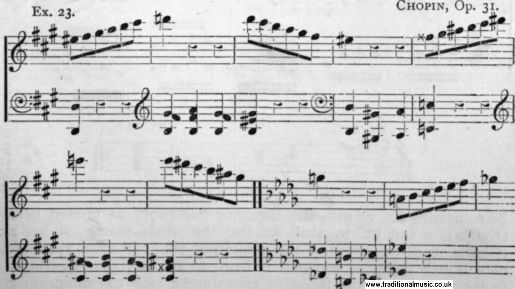MUSICAL MEMORY - online book
A System To Cultivate The Musical Memory For Musicians.
| Share page | Visit Us On FB |
|
MUSICAL MEMORY. |
27 |
||
|
Sonata in B flat, Op. 22, beginning at the 24th bar after the double bar. A corresponding ascent of the bass may be seen in the first movement of the Sonata in D minor, Op. 31, No. 2, beginning at bar 21, and in the transposition of this passage in the development portion, where the bass ascends stepwise, first at distances of four bars and afterwards at distances of two bars. Another and similar example will be found in this same Sonata in the development of the last movement, where at bar 32 after the double bar, the bass ascends from the lower C to the B flat above. This ascent also proceeds first at intervals of four bars, and afterwards at shorter distances. But the finest example of such a device is in the development of the first movement of the Sonata "Appassionata," where the bass ascends from the lower D flat gradually for two octaves, and then by minor 3rds for another two octaves, finally descending by 3rds throughout the whole four octaves.
50. A device of another kind is regularity in the sequence of keys. This may be seen in the development of the first movement of the Sonata in E flat, Op. 31, No. 3, where, beginning at the 12th bar after the double bar, it proceeds through keys at the distance of a 4th, that is, in the relationship of Dominant to Tonic. Another example is the development of the first movement of the Sonata in A flat, Op. no, where a descending melodic sequence in the treble takes place simultaneously with a progression of keys descending in 3rds (F Minor, D flat, B flat Minor). Another instance of the employment of 3rds in regulating the progression of keys, but this time ascending, may be seen in the " second subject" of the first movement of the Sonata in A major, Op. 2, No. 2. Many instances of the employment of other forms of sequence could be quoted from Beethoven's works, it may therefore be more interesting and instructive to give, as a concluding example, one from the works of another composer of quite different methods and genius. In Ex. 23 we see a real sequence of four bars rising a tone at each occurence. The sequence really begins eight bars before what is here printed, but this extract will be sufficient to illustrate our point. |
|||
 |
|||